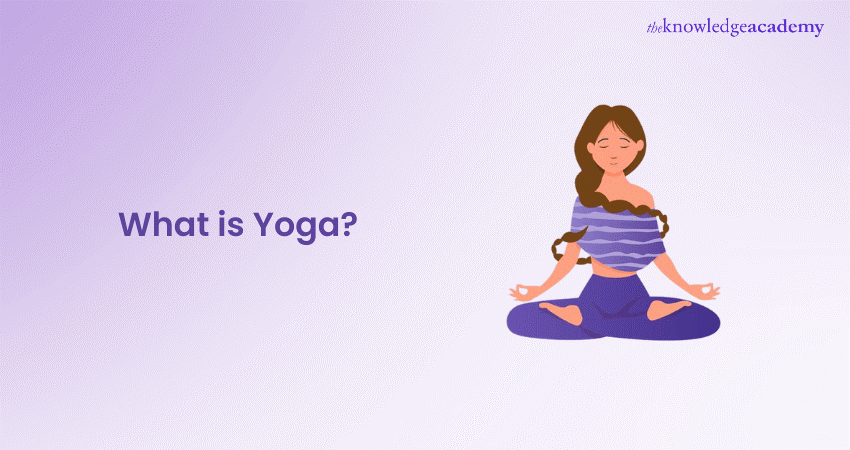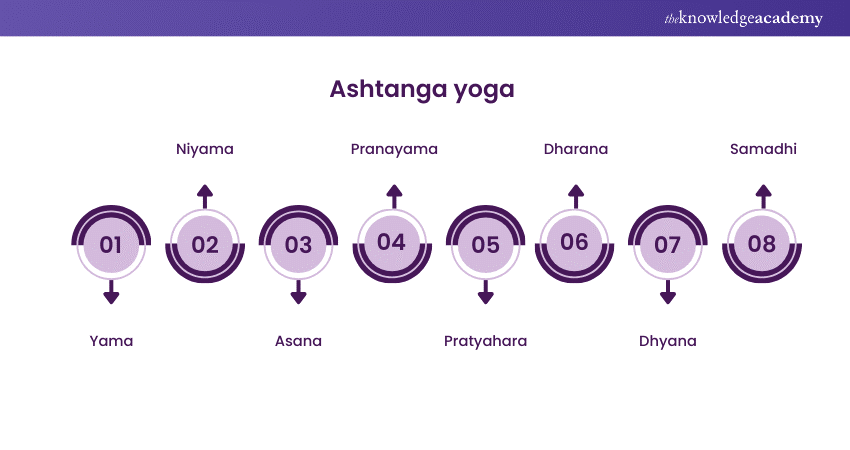We may not have the course you’re looking for. If you enquire or give us a call on 01344203999 and speak to our training experts, we may still be able to help with your training requirements.
Training Outcomes Within Your Budget!
We ensure quality, budget-alignment, and timely delivery by our expert instructors.

Yoga is a holistic wellness practice that’s all about uniting your body and mind. It’s not just about stretching; it’s a journey to improve your posture, fitness, and overall health. The term ‘Yoga’ comes from the Sanskrit word ‘yoke’, which signifies a union. This ancient practice, deeply rooted in Indian culture, involves physical postures, breathing exercises, and meditation to help you build strength, tolerance, and mindfulness.
While Yoga has gained immense popularity in the West, it’s important to remember its traditional elements like mantra chanting, which are often left out in modern adaptations. Read along to gain an in dept understanding of What is Yoga and how it can benefit you in your day-to-day life.
Table of contents
1) Understanding What is Yoga?
2) What is the Purpose of Yoga?
3) Advantages of Yoga
4) Different Types of Yoga
5) Tips to Consider
6) Conclusion
Understanding What is Yoga?
Yoga is a practice that originated from Vedas (Indian Philosophy). It incorporates the practice of specific breathing exercises, physical postures and meditation methods. These practices help you manage both your physical and mental health. It also helps you build your strength and flexibility by practising movements that are said to align your Chakras in order to obtain unity between body and mind.
‘Chakra’ is a Sanskrit word that means ‘wheel’ or ‘circle’. In this context, Chakras refer to the energy centres of your body. Yoga believes aligning the Chakras has the power to influence your physical and mental well-being.
What is the Purpose of Yoga?
The purpose of Yoga is to cultivate awareness, self-regulation, and higher consciousness in individuals. Yoga aims to make you more aware of yourself and your surroundings. It incorporates different methods to not only better your physical health but also manage your stress levels. Consistent physical activities like practising Yoga also promote a healthier lifestyle that helps prevent illnesses.
Advantages of Yoga
As you may already know, Yoga is a wellness practice that has a lot of benefits for your physical and mental health. But are you aware of the Benefits of Yoga? Well, let’s take a look.
Build Strength and Increase Flexibility
The postures practiced in Yoga, promote flexibility and movement. Practicing these different postures and retaining such posture builds resistance and strength. Over time with consistent practice, Yoga helps you build strength and increase the flexibility of your body.
Relives Stress and Improves Mental Health
Yoga helps practice mindfulness, being mindful can help you reduce your stress levels and improve your mental health. It also helps heal the mind from trauma and depression and life a more fulfilling life.
Aids with Digestion and Strengthens Immunity
A less-known advantage of Yoga is that it aids your digestion process and strengthens your immunity. The breathing exercises help your bowel movements to be smoother. This prevents the build-up of stomach gasses and indigestion that could lead to health issues that, over time, weaken your immunity.
Reduces Inflammation and Body Pain
If you suffer from chronic back pain or inflammatory issues, you should give Yoga a try! The movements involved in Yoga are strategically crafted to release stiffness in muscles and reduce inflammation. This helps ease out a great deal of your body pain.
Improves Brain Functioning and Sleep Quality
Most Yoga postures, if not all, aim to balance out different elements of your body. In addition to all it is benefits, it also helps you carry your own body better in a more balanced and harmonious way.
Additionally, the practice has also been known to drastically improve your sleep quality. Sleep quality also has a play in your brain functioning and, with its improvements, it does contribute to improving the overall brain functions.
Are you ready for a lifestyle makeover? Join our Healthy Lifestyles Training to learn how to achieve your health goals effectively.
Improves the Balance of Your Body
Most Yoga postures if not all aim to balance out different elements of your body. In addition to all it is benefits, it also helps you carry your own body better in a more balanced and harmonious way.
Improves Cardiovascular Health
If you have issues with your blood pressure or have an unfortunate predisposition to heart problems due to genetics, you should consider practising Yoga. Yoga helps regulate your cardiovascular functioning and prevents the adverse effects of heart problems and blood pressure issues.
Different Types of Yoga
Originally practised in India by the Yogis (traditional yoga practitioners and spiritual mentors), the practice of Yoga has evolved to have many types. Some of the popular types of Yoga are explained in detail below:
Hatha Yoga
Hatha Yoga is about establishing balance between body and mind. The words ‘Hatha’ are broken down as ‘Ha’ and ‘tha’, representing the sun and the moon. The term Hatha is meant to portray a balance in the universe, similar to the concept of yin and yang. It typically involves only physical postures (asana) and breathing exercises. These can aid you in establishing a balanced body and mind.
Ashtanga Yoga
Ashtanga Yoga is an incorporation of the eight limbs of Yoga. The word is derived from the Sanskrit words ‘Ashta’, referring to the number eight, and ‘Anga’, meaning limbs or body parts. According to the scriptures, Yoga has eight limbs. The eight limbs are as follows:

1) Yama – A set of moral codes to live by.
2) Niyama – Physical observances and the practice of self-discipline.
3) Asana – Practicing proper physical posture.
4) Pranayama - Breathing exercises that teach you breath control.
5) Pratyahara - The withdrawal of senses from worldly distractions.
6) Dharana - The practice of concentration and focusing of the mind.
7) Dhyana - The practice of meditation and focusing the mind on a single point.
8) Samadhi - The mental process of attaining oneness with the self.
Iyengar Yoga
Iyengar Yoga is an evolution of the classic Hatha Yoga, a more precise and clear method of Yoga for modern practitioners to adapt easily. Iyengar Yoga focuses on three aspects - alignment, sequencing, and timing. Alignment in Yoga refers to the arrangement of your body in the Yoga postures. Sequences here refer to the order of practicing the postures. Timing refers to the timespan you can hold the postures safely while respecting the boundaries of your body. This form of Yoga promotes the use of props to assist asanas to effectively align the body.
Bikram Yoga
Invented in 1970 by Bikram Choudhary, Bikram is a form of Yoga that incorporates the use of heat in the process of Yoga. Heat allows the muscles to stretch easier and makes you sweat out toxins aiding weight loss. Bikram Yoga has a set of 26 poses that you move through rapidly until the end of the session, which is usually 90 mins long. The 26 poses of Bikram Yoga are standard everywhere.
Kripalu Yoga
Kripalu Yoga is a gentle adaptation of Hatha Yoga that gives equal importance to mind, body and spirit. Kripalu Yoga is a great option if you are a beginner to Yoga.
Kundalini Yoga
The word ‘Kundalini’ originated from the Sanskrit word ‘Kundal’ which means circular and refers to a coiled snake. Kundalini is a form of Yoga that involves singing, chanting, and breathing exercises to activate your Kundalini energy. A circular life force that is coiled at the base of the spine that can be activated through Yoga and meditation.
Learn how to craft personalised Yoga in our Yoga Training- Sign up today!
Tips to Consider
If you are starting your journey with Yoga, here are some tips to keep in mind to be able to practice Yoga consistently:
Establishing a Time Frame
To practice Yoga regularly you must specify a time for you to practice daily. Also maintain a timespan you would dedicate to the practice every day. Creating a schedule plan for a week or a month can help you stay consistent.
Choosing the Right Space
To practice Yoga, you will require an open area that facilitates movement. Choosing an area that is clean and free of clutter is recommended. The environment you choose to practice in may also influence your state of mind.
Practice on a Light Stomach
It is advised to practice Yoga on a light stomach, practicing on a heavy stomach would cause discomfort. Certain postures in Yoga also may cause you to regurgitate undigested food. Additionally, heavy meals do make you feel lethargic and may restrict movement.
Do not Rush the Process
It's important to start slowly and be gentle. Yoga promotes respecting your body's boundaries. It doesn't require you to push your body past its limits; it builds strength and flexibility slowly and consistently.
Conclusion
Now that you know What is Yoga through this blog, embracing Yoga as a daily practice can be transformative. It offers a path to enhanced strength, flexibility, and mental clarity. It’s essential to approach it with mindfulness and regularity to truly reap its rewards. In this blog, we’ve explored the essence of Yoga, delved into its various forms, and highlighted the myriad benefits it can bring to your life. Whether you’re seeking physical well-being, emotional balance, or spiritual growth, Yoga provides a comprehensive approach to nurturing all aspects of your being.
Practice Meditation to improve your concentration power – join now in our Meditation Course!
Frequently Asked Questions

Yoga is known to help calm the mind and reduce stress levels significantly. Additionally, it can also be used to treat depression, anxiety and trauma disorder. Practising Yoga promotes mindfulness and can also be a great way to manage anger issues and frustration.

Quitting smoking is a personal choice backed by intention. However, you can use Yoga to manage stress and other ailments that you might otherwise relate to smoking.

The Knowledge Academy takes global learning to new heights, offering over 30,000 online courses across 490+ locations in 220 countries. This expansive reach ensures accessibility and convenience for learners worldwide.
Alongside our diverse Online Course Catalogue, encompassing 17 major categories, we go the extra mile by providing a plethora of free educational Online Resources like News updates, Blogs, videos, webinars, and interview questions. Tailoring learning experiences further, professionals can maximise value with customisable Course Bundles of TKA.

The Knowledge Academy’s Knowledge Pass, a prepaid voucher, adds another layer of flexibility, allowing course bookings over a 12-month period. Join us on a journey where education knows no bounds.

The Knowledge Academy offers various Healthy Lifestyles Training, including Active Healthy Lifestyle Training, Cognitive Behavioural Therapy Training, Yoga Training, and Nutrition Courses. These courses cater to different skill levels, providing comprehensive insights into Mindfulness.
Our Health & Safety Blogs cover a range of topics related to Meditation, offering valuable resources, best practices, and industry insights. Whether you are a beginner or looking to advance your Meditation skills, The Knowledge Academy's diverse courses and informative blogs have you covered.
Upcoming Health & Safety Resources Batches & Dates
Date
 Life Coach Training
Life Coach Training
Fri 22nd Nov 2024
Fri 14th Feb 2025
Fri 11th Apr 2025
Fri 13th Jun 2025
Fri 15th Aug 2025
Fri 10th Oct 2025
Fri 12th Dec 2025







 Top Rated Course
Top Rated Course



 If you wish to make any changes to your course, please
If you wish to make any changes to your course, please


